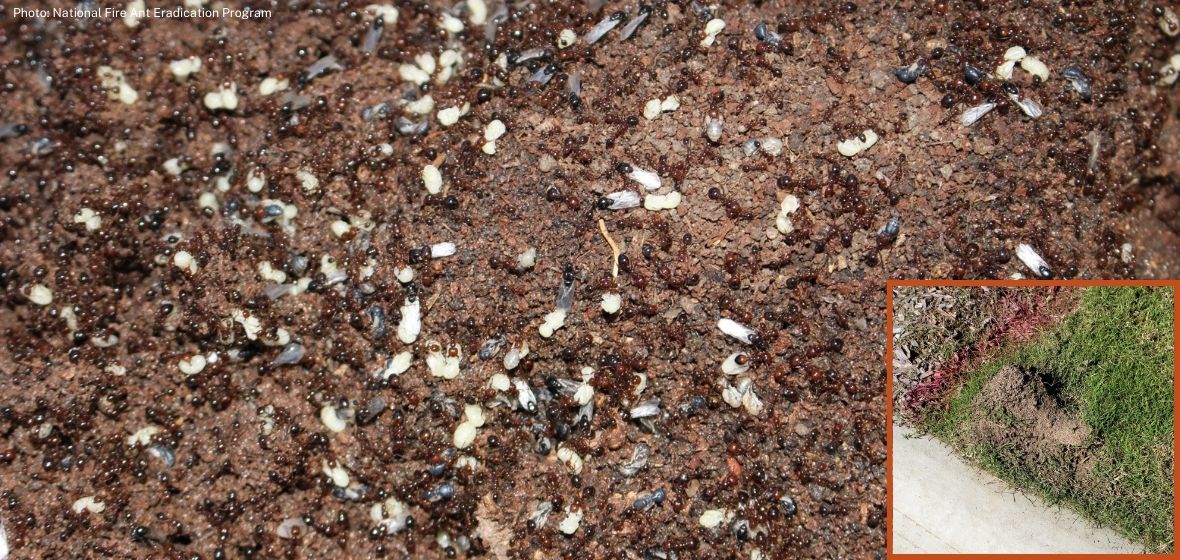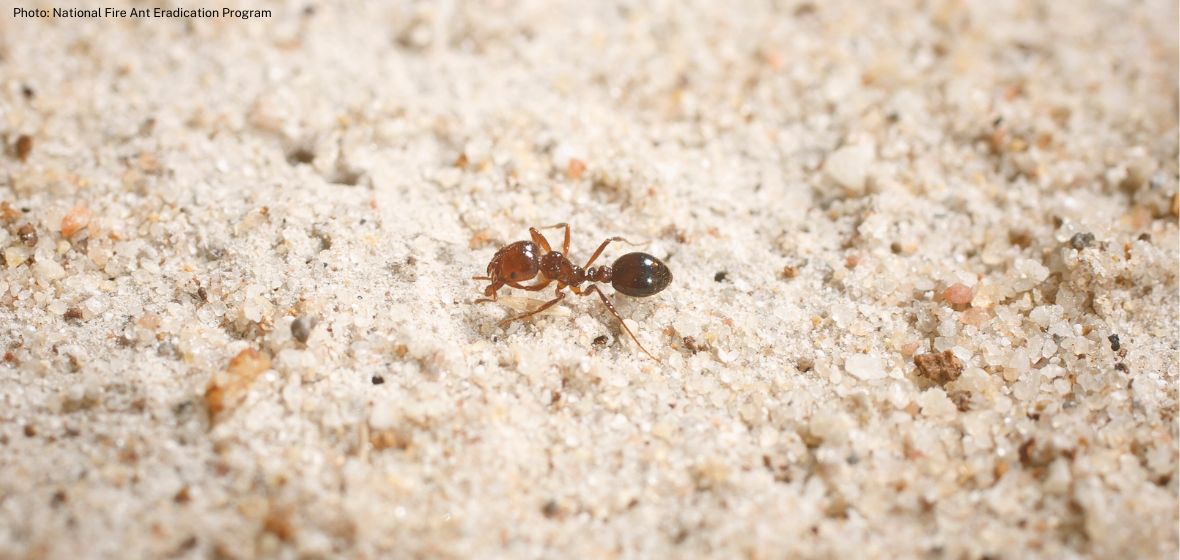Updated
Breaking news | As of 27 July 2023, fire ants have been discovered just 5 kilometres from the Queensland–New South Wales border. It could mean the potentially deadly invasive species has already breached state lines.
25 July 2023
Invasive fire ants are one of Australia’s greatest environmental threats. So, why has the Australian Government slashed spending on their eradication?
The red imported fire ant or fire ant (Solenopsis invicta), native to South America, has been making their mark since their accidental introduction to Australia in the 1990s. The invasion has spread in Queensland and is now 12km north of the New South Wales border, posing a severe threat to humans and Australian ecosystems.1
A review conducted in 2021 on the National Red Imported Fire Ant Eradication program concluded that a budget of at least $250 million per year is essential to eradicate this pest.
However, on 13 July 2023, federal Agriculture Minister Murray Watt announced a shocking decision to significantly reduce spending. The federal government has allocated only $60 million in funding for the fire ant control program in 2023, less than two-thirds of the $94 million spent on eradication efforts in 2022.2
Wildlife Queensland is deeply concerned about this decision. Reducing spending to contain, let alone eradicate, fire ants is disheartening. The question remains: where is the necessary $200 to $300 million to ensure the complete eradication of fire ants by 2032?
“Wildlife Queensland has been a strong advocate for Red Fire Ant eradication,” said Wildlife Queensland’s Policies and Campaigns Manager Des Boyland.
“If funds required to conduct an effective eradication program are not provided, our lifestyle, agricultural industries and wildlife will all be impacted. Without eradication, our lives will never be the same.”
Introduction and spread
In Queensland, fire ants were first detected at the Port of Brisbane in 2001, and despite immediate efforts to contain them, they quickly established colonies and began spreading.3 The warmer climate of Queensland has proved to be an ideal habitat, allowing these ants to thrive and multiply.
Since its introduction to the United States in 1945, the fire ant was recorded in 13 states in 2004, occupying over 128 million hectares of land. These invasive pests have severely impacted their agriculture industry, reducing crop yield, increasing livestock mortality, damaging equipment and infrastructure, and disrupting livelihoods.4
Analysis shows that if the fire ant was to become widespread in Australia, adverse impacts are likely in most sectors of the economy, affecting plant and animal industries, the environment, development, infrastructure and health and lifestyle.5
Fire ants pose a severe risk to human health and safety. Their stings are painful as the alkaloid venom causes pustules and, in some people, allergic reactions. About 85-100 people die every year in the United States from fire ant bites.1
Impact on wildlife and ecosystems
Beyond the threats to human health, fire ants have a profound impact on native Australian wildlife and ecosystems. Their vast appetite for insects, small vertebrates, and seeds disrupts the balance of local ecosystems. By preying on native fauna, they can affect existing food chains and threaten the survival of many native species.
Australian wildlife affected by fire ants includes ground-nesting birds, small mammals, reptiles, invertebrates and amphibians.6 Many of these species have evolved without natural defences against such invasive predators, making them highly susceptible to the impacts of fire ants.
If left unchecked, fire ants will have severe ecological impacts because they reach extremely high densities. An assessment of their likely impact on 123 animals in southeast Queensland predicted population declines in about 45% of birds, 38% of mammals, 69% of reptiles and 95% of frogs. These reductions could result in possible extinctions.7
Fire ant biology
What do fire ants look like? They are small reddish-brown insects measuring about 2 to 6 millimetres in length. These aggressive ants have a copper-coloured head and darker abdomen.
Their nests are large dome-shaped mounds of soil and debris, typically found in open fields, lawns, and near water sources. The nest size can be up to 40 cm high and 50 cm in diameter and can house colonies that number in the hundreds of thousands.
Fire ants exhibit interesting behaviours, such as latching onto each other in flooded areas to make a raft out of themselves and discarding scraps and dead ants onto rubbish piles outside the nest.4
Moving forward
Queensland must eradicate fire ants before it threatens ecosystems, biodiversity, human health and lifestyle, and the agricultural industry.
Historically, infestations have been eliminated at Gladstone, Sydney and Fremantle. Therefore, eradication of this pest is possible, but funding and staff are required.
A new response plan has been announced today, 25 July 2023, by the Queensland Government. Queensland funding will back the efforts of the National Program, focusing on scaling up operations to strengthen containment and compliance.8
“The National Program cannot eradicate fire ants alone. We need the community, industry and all levels of government to play an active role in managing fire ants on property they own or manage,” said Minister for Agricultural Industry Development and Fisheries and Minister for Rural Communities Mark Furner.
Community education is also vital, so individuals can help check for and report suspicious ants and avoid spread within the infestation zone.
In conclusion, the eradication of fire ants must be urgently addressed. Australia must take a proactive and well-funded approach to eliminate this environmental menace. The consequences of inaction could be catastrophic, and now is the time to stand united in the fight against these invasive pests.
What you can do
- VOICE your concern by emailing Annastacia Palaszczuk, Premier and Minister for the Olympic and Paralympic Games.
- SIGN the Invasive Species Council petition on Red Fire Ants.
- REPORT your sighting if you discover fire ants or a fire ant nest.
For more Wildlife Queensland articles on fire ants, please see Putting the heat on fire ants in the suburbs and Fighting fire ants in Ipswich with free bait.
Notes:
- Red fire ants now 12km north of Queensland-NSW border prompting calls for funding injection, checkpoints – ABC News
- Fire ant funding failure puts Australia at risk – Invasive Species Council
- Red imported fire ant – Wikipedia
- Environmental impacts | National Fire Ant Eradication Program (fireants.org.au)
- Reduction in native fauna and flora due to red imported fire ant
- Red Imported Fire Ant in Australia: What if we lose the war? (https://onlinelibrary.wiley.com/doi/10.1111/emr.12238)
- https://statements.qld.gov.au/statements/98290


